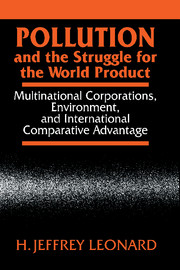 Pollution and the Struggle for the World Product
Pollution and the Struggle for the World Product Economic historians may well look back on the last quarter of the twentieth century as marking the decline of the pattern of world trade and industrial production that had been the hallmark of the two previous centuries – the international division of labor under which a small number of core manufacturing countries accounted for an overwhelming percentage of global industrial production and a large number of periphery or developing countries provided raw materials and simple primary products to feed the industrial economies. This transition has been set in motion by a number of interactive forces, including
the ascendence of increasingly stateless multinational corporations bent on maximizing profits and minimizing production costs through the integration of global production units,
the internationalization of investment capital and financial markets,
the emergence of a new wave of rapidly industrializing nations in the periphery, and
the evolution toward “postindustrial” economies that has commenced in the United States, Japan, and a few countries of Europe.
In the midst of these forces – trying to shape, cope with, and stave off their impacts – stand the nearly two hundred individual nation-states that constitute the postcolonial political world. In general, the industrialized nations are trying to keep up the pace of innovation necessary to remain competitive in highly technological industries and at the same time to hold onto a critical mass of low-technology industries to maintain current levels of employment.
To save this book to your Kindle, first ensure [email protected] is added to your Approved Personal Document E-mail List under your Personal Document Settings on the Manage Your Content and Devices page of your Amazon account. Then enter the ‘name’ part of your Kindle email address below. Find out more about saving to your Kindle.
Note you can select to save to either the @free.kindle.com or @kindle.com variations. ‘@free.kindle.com’ emails are free but can only be saved to your device when it is connected to wi-fi. ‘@kindle.com’ emails can be delivered even when you are not connected to wi-fi, but note that service fees apply.
Find out more about the Kindle Personal Document Service.
To save content items to your account, please confirm that you agree to abide by our usage policies. If this is the first time you use this feature, you will be asked to authorise Cambridge Core to connect with your account. Find out more about saving content to Dropbox.
To save content items to your account, please confirm that you agree to abide by our usage policies. If this is the first time you use this feature, you will be asked to authorise Cambridge Core to connect with your account. Find out more about saving content to Google Drive.